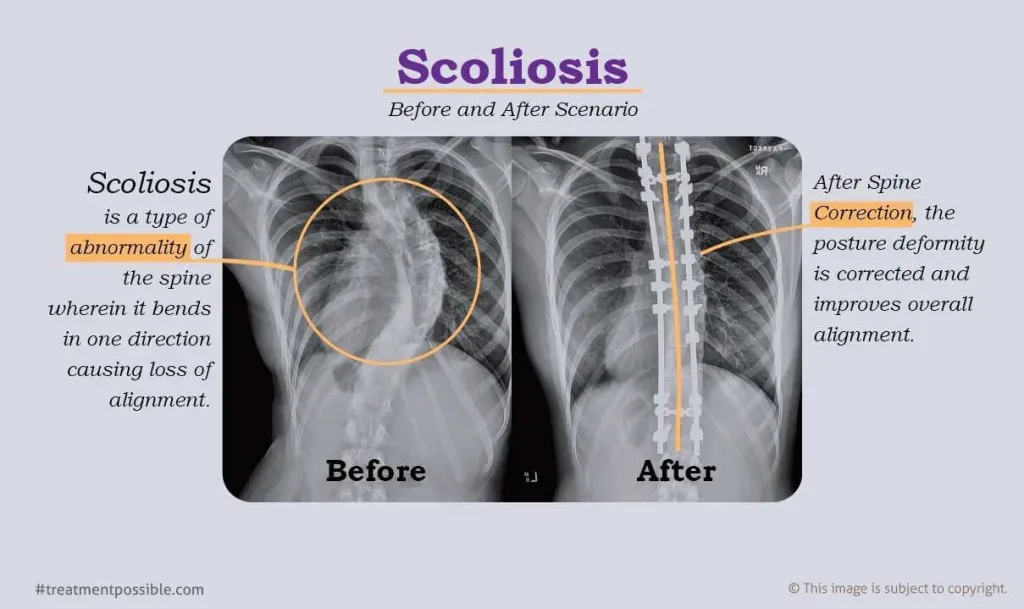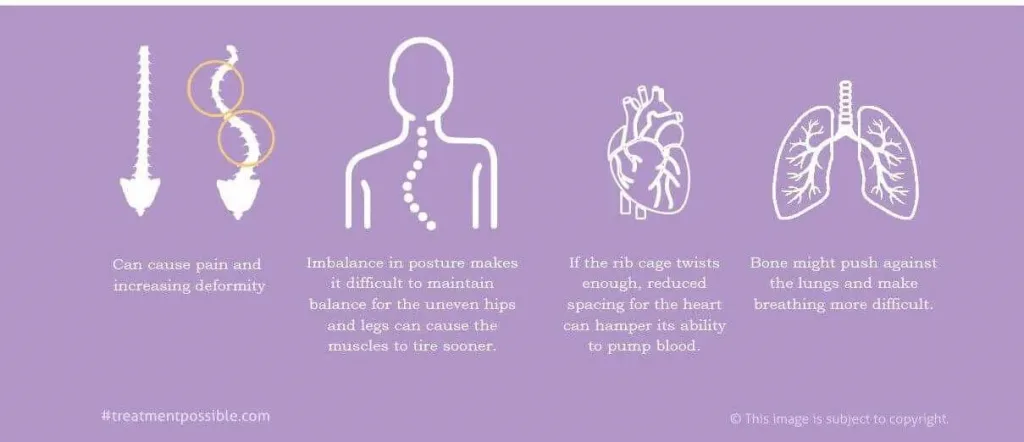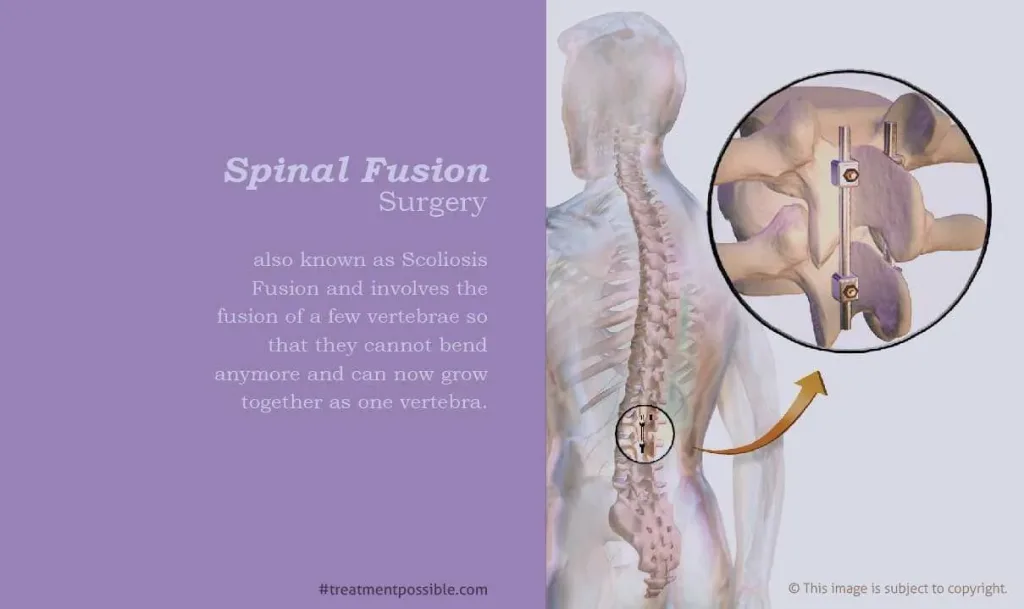Scoliosis Surgery
Verified By: Dr. Akhil Tawari (MBBS, MS (Orthopedics), DNB (Orthopedics), and D-Ortho)
What Is Scoliosis?
Scoliosis is a type of abnormality of the spine in humans wherein the spine bends in one direction causing loss of alignment. The curve may be in the shape of a C or an S. Scoliosis is a disease that starts to show effects from early teenage, however, there are not any major visible scoliosis symptoms.

There are two major types of scoliosis namely Degenerative Scoliosis and Idiopathic Scoliosis. The visible Scoliosis symptoms include the uneven fitting of clothing or sideways curvature of the body, change in the way of walking and hip alignment, difficulty in breathing, pain in the back, cardiovascular problems, and much more.
The Scoliosis condition, if diagnosed early can be treated by the wearing of spinal braces so that the curve does not progress into something else. However, if the spinal curvature cannot be controlled with a body brace, Scoliosis spine surgery is prescribed. The aim of the scoliosis surgery is to help to stop the curve from progressing any further.

What are the Types of Scoliosis Surgery?
There are three common surgical options for Scoliosis surgery:
- Spinal Fusion Surgery: This procedure is also known as Scoliosis Fusion and involves the fusion of a few vertebrae so that they cannot bend anymore and can now grow together as one vertebra. Various instruments like rods, wires, and hooks are used to achieve this. This is one of the most effective surgical procedures for scoliosis.
- Growing System Spine Surgery: This surgery is also known as Growth Rod Surgery and is mainly performed in growing children whose spine is still developing. A few rods are fixed into the spine by a spine surgeon to correct the curve as the child progresses to develop. This surgical approach has to be repeated every 6 to 8 months. Once the child has matured completely, he undergoes spinal fusion.
- Fusion less Spinal Surgery: This method is based on the theory that if constant pressure is applied to the spine, it will start growing slower and much denser. This major surgery involves attaching screws to the outer curvature and then pulling them with a string in order to straighten the spine.

The degree of the condition and the location of the curve are two very important things to keep in mind before undergoing a surgery. Scoliosis surgery is determined based on the age and whether the spine is still in the growing period or not.
How is Scoliosis Surgery Performed?
Surgery is usually reserved for people with curves greater than 40 degrees. Scoliosis correction surgery is done using pedicle screws and rods.
- Step 1: The pedicle screws are placed into the individual vertebrae and a contoured rod is placed and the screws are connected to it.
- Step 2: The spine is fused using autograft and allograft bone available from the bone bank. The skin is closed using absorbable sutures so that the cosmetic appeal is maintained.
- Step 3: The operation lasts 4–8 hours and they may have to remain in the hospital for a week to 10 days.
- Step 4: They will need to return to the hospital every 6 months to have the rods lengthened.
Patient Testimonial
What are the Alternatives for Scoliosis Surgery?
If the spine is still growing, then it is not a good idea to go for the surgery. In such cases, there are treatment options to be considered for scoliosis. The treatment options for scoliosis are reserved for children whose curves are lesser than 40 degrees. The options are as below:
1. Casting:
Casting instead of bracing is sometimes used for infantile scoliosis to help the infant’s spine to go back to its normal position as it grows. This can be done with a cast made of plaster of Paris.
The cast is attached to the outside of the patient’s body and will be worn at all times. Because the infant is growing rapidly, the cast is changed regularly.
2. Braces:
In case of a moderate scoliosis where the bones are still growing a brace is recommended. This will prevent further curvature, but will not cure or reverse it. Braces are usually worn all the time, even at night. The more hours per day the patient wears the brace, the more effective it tends to be. When the bones stop growing, braces are no longer used.
Braces won’t straighten the spine, but they can prevent the curvature from increasing. This method of treatment is more effective for cases that are detected early. The aim of bracing is to reduce the risk of the condition getting worse. There are two types of braces:
- Underarm brace / Thoracolumbosacral orthosis (TLSO) – the TLSO is made of plastic and it is designed to fit neatly around the body. It is usually used to treat lower spine curves and it is not usually visible under clothing.
- Milwaukee brace – This brace starts at the neck and covers the entire torso, with the exception of the legs and arms. This type of brace is only used when the TLSO is not possible or not effective.
3. Chiropractic treatment:
It is important to visit a chiropractor who specializes in scoliosis. Receiving chiropractic treatment from a non-specialist can make symptoms worse.
Chiropractic treatment can improve the quality of life but it is not a cure. Although it can help people with scoliosis feel better, it does not resolve the curvature of the spine.
Want more clarification about medical expense & treatment plan?
Plan for Scoliosis surgery In India
Scoliosis Surgery at Treatment Possible:
Treatment Possible is associated with Top Spine Surgeon in India who are specialized in Scoliosis Surgery. We work with the best spine surgery hospital in India that are equipped with OT that are compatible for complex spine surgeries. Treatment Possible associates with the best spine specialist in India who are experienced in operating complex scoliosis cases on a Child as well as on an adult.
The scoliosis surgery cost in India ranges from USD 6000-8000 which is much lower compared to the cost of the scoliosis surgery in the United States or Europe. Treatment Possible ensures high-quality Scoliosis surgery in India while guaranteeing the lowest medical services and surgery cost, especially for Scoliosis Fusion Surgery. Our understanding of the Indian Medical Services, Healthcare market and our valued relations with the best spine surgeon in India enables us to provide the spine surgery in India at a price that is reasonable, affordable and transparent.
Get Free Consultation with the Top 10 Spine Surgeon in India with the hassle-free setup of post-operative recovery care, medical travel & stay during the medical treatment. You can also send your medical reports for Scoliosis Spine Surgery to care@treatmentpossible.com for free opinions and suggestions from the India best spine surgeon. No matter what the health condition, you always get good healthcare options and cost advantage from Treatment Possible!

